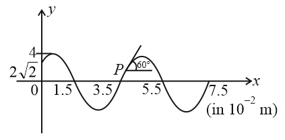Embibe Experts Solutions for Chapter: Wave Motion on a String, Exercise 4: Exercise-4
Embibe Experts Physics Solutions for Exercise - Embibe Experts Solutions for Chapter: Wave Motion on a String, Exercise 4: Exercise-4
Attempt the free practice questions on Chapter 20: Wave Motion on a String, Exercise 4: Exercise-4 with hints and solutions to strengthen your understanding. Beta Question Bank for Engineering: Physics solutions are prepared by Experienced Embibe Experts.
Questions from Embibe Experts Solutions for Chapter: Wave Motion on a String, Exercise 4: Exercise-4 with Hints & Solutions
The figure shows a snap photograph of a vibrating string at . The particle is observed moving up with velocity . The tangent at makes an angle with -axis (i) Find the direction in which the wave is moving (ii) the equation of the wave (iii) the total energy carried by the wave per cycle of the string. [Assuming that , the mass per unit length of the string

The harmonic wave travels along a string towards a boundary at with a second string. The wave speed on the second string is . If expressions for reflected and transmitted waves are and respectively . Assume SI units. Find .
The displacement of the medium in a sound wave is given by the equation where , and are positive constants. The wave is reflected by an obstacle situated a . The intensity of the reflected wave is times that of the incident wave. If
(i) the wavelength and frequency of incident wave are respectively.
(ii) the equation for the reflected wave is
(iii) In the resultant wave formed after reflection, the maximum and minimum values of the particle speeds in the medium are .
(iv) the resultant wave as a superposition of a standing wave and a travelling wave is.
then find .
A metallic rod of length is rigidly clamped at its mid point. Longitudinal stationary waves are setup in the rod in such a way that there are two nodes on either side of the midpoint. The amplitude of an antinode is . If the equation of motion of wave at a point from the midpoint and those of the constituent waves in the rod are , respectively then find . (Young's modulus of the material of the rod density ). Both ends are free.
A parabolic pulse given by equation travelling in a uniform string. The pulse passes through a boundary beyond which its velocity becomes . What will be the amplitude (in ) of pulse in this medium after transmission?
